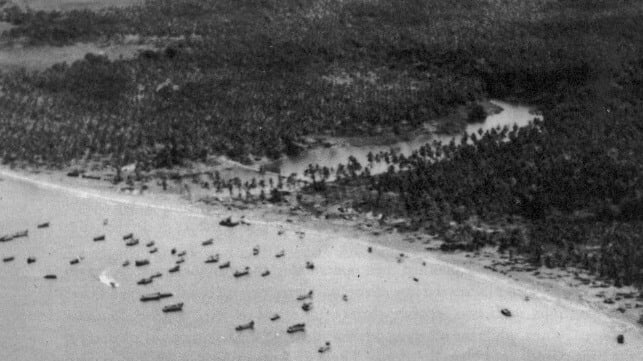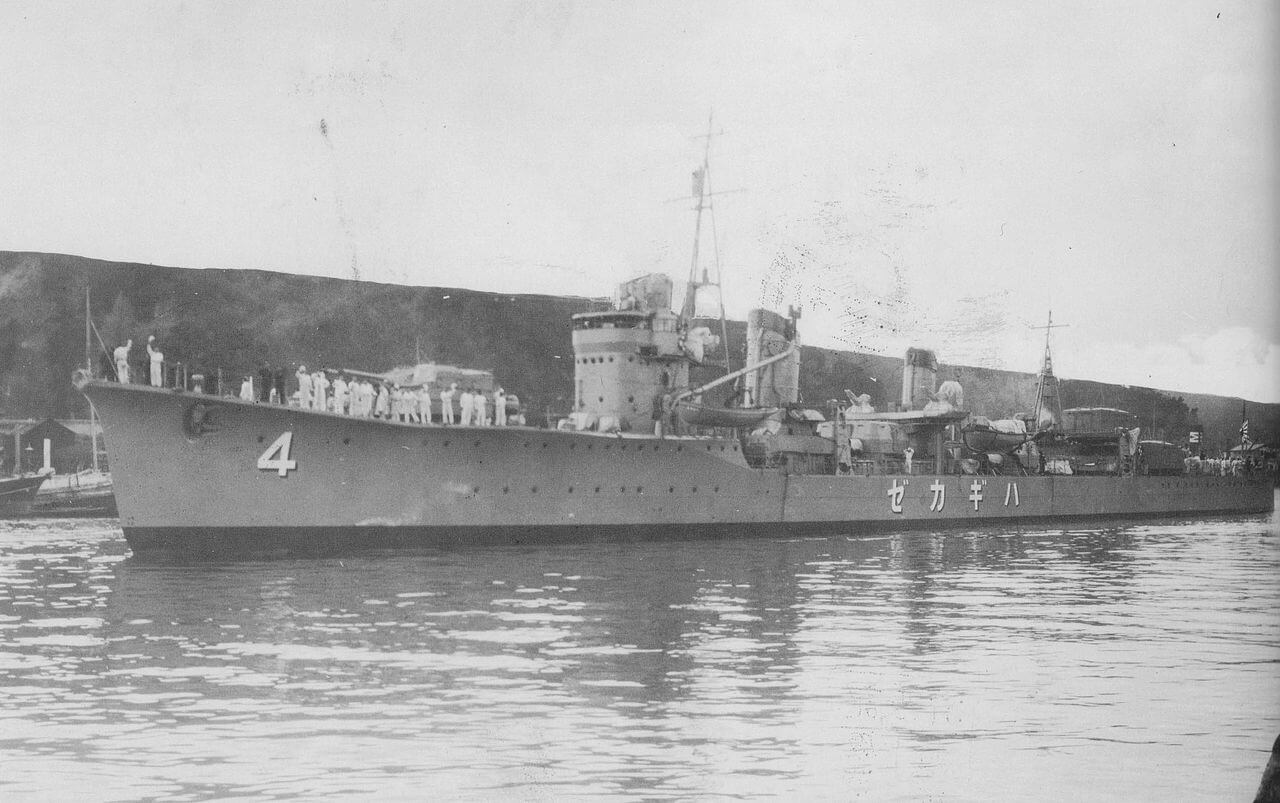Robert Canavan's Impossible Story of Survival at Guadalcanal

[By William H. Thiesen, Ph.D., Coast Guard Atlantic Area Historian]
In August 1942, during the initial stages of World War II’s Guadalcanal campaign, the local waters of Iron Bottom Sound concealed numerous Japanese submarines. With no Allied patrol craft available to defend against this deadly menace, Coast Guard landing craft based at Guadalcanal began nightly anti-submarine patrols.
Each of the patrol’s three LCPs (landing crafts personnel) took responsibility for a different part of Iron Bottom Sound. An early design of landing craft with a top speed of only eight knots, the LCP carried a crew of three and boasted a snub-nosed bow supporting side-by-side machine gun tubs. Each position held an air cooled, .30-caliber Lewis machine gun, and the helm and engine controls sat behind the tandem gun emplacements. The crews fitted their boats with depth charges set for 50 feet, a depth that would likely have sunk the enemy sub and LCP at the same time.
On Tuesday, Aug. 18, Coxswain Robert “Bob” Canavan volunteered to pilot one of the anti-submarine patrol boats. Coast Guardsmen Petty Officer 1st Class Charles Stickney (BM1), Petty Office 3rd Class John Alcorn (MM3) and Petty Officer 2nd Class Charles Williams (BM2) volunteered to join him. Together with two Marine volunteers, the crew embarked on a journey that only one man would survive.
While the other LCPs deployed for their sectors of the sound, Canavan steered his boat into the dark night to patrol near the small, volcanic Savo Island. Shortly before dawn on the 19th, Canavan sighted a warship steaming over the horizon from the west of Guadalcanal and assumed it was friendly. Instead, the ship was the large 35-knot destroyer IJNS Hagikaze on a shore bombardment mission and headed in Canavan’s direction. Realizing the vessel was an enemy warship, Canavan pushed his throttle to the stops and set off on a zigzag course for the opposite side of the sound from Guadalcanal.
Canavan’s evasive maneuvers proved too little too late. With a top speed over four times that of the LCP, Hagikaze quickly overtook Canavan and enemy machine gunners began raking his boat. The crew’s hopes of escape faded fast, so Canavan remained at the helm while his shipmates donned life preservers. One at a time, the marines, Williams, Alcorn, and Stickney jumped overboard. The last man over, Stickney, shouted, “I’ll see you in hell, Bob!” Kneeling at the wheel, Canavan tried to escape, but machine gun fire hit the boat controls. With the situation hopeless and no time to spare, Canavan locked the wheel hard right and plunged over the side. He later recounted how he cheated death the first of many times: “As I hit the water, a burst of gunfire hit the (floor)boards where I had been kneeling.”
Hagikaze closed on the abandoned LCP and shot out its motor. A small party boarded the boat, and stripped out its machine guns and equipment before the destroyer sent it to the bottom of the sound. Next, the Japanese warship retraced its course to deal with the LCP crew. Canavan wore no life preserver and could do no better than play dead. To his astonishment, the ploy worked and the enemy left him alone.
Canavan had cheated death a second time, but luck ran out for his five shipmates. The Japanese located the others floating defenseless in the dark water, machine-gunned them and left them to the sharks. They were never seen again. This was one of many wartime instances where Coast Guardsmen perished together with their Marine Corps brethren.
After murdering Canavan’s shipmates, Hagikaze resumed its course across the sound to shell Tulagi Island, which had fallen to the U.S. Marines over a week earlier. Meanwhile, fate had dealt Canavan the gift of life as well as a certain death sentence. As the day dawned, he found himself afloat and all alone in shark-infested waters. He was clad only in shorts with no life preserver, and a dozen miles from the nearest land. And so began one of the greatest stories of physical endurance in the history of the Coast Guard.

At first, Canavan’s chances of survival appeared so bleak that he considered drowning himself. However, he changed his mind, deciding instead to attempt to swim across Iron Bottom Sound. He set out toward Marine-occupied Tulagi, conserving his energy by using the sidestroke and backstroke. According to Canavan, “I did more praying in those hours I spent in the water than I had done in the twenty previous years of my life.” His prayers were answered after swimming throughout the day and late into the night — Canavan reached the shoreline of Florida Island. He had covered over a dozen miles of ocean water in about 20 hours. Lady luck had smiled on him once again.
Canavan emerged from the water, the soles of his feet slashed on coral under the island’s surf line. Despite his wounds, he collapsed on the beach and fell into a deep sleep. He remained there for so long that the natives covered him with protective palm fronds. When he awoke, Canavan tried to eat a coconut for nourishment, but could not stomach the coconut milk or meat. The rest of that day, he hobbled along Florida Island’s shoreline through deserted native villages toward the American occupied island of Tulagi.
After sleeping a second night on Florida Island, Canavan located the nearest point to Tulagi. Dehydrated, sun burnt and exhausted, and with 400 yards of water separating him from a marine outpost on Tulagi, Canavan tried to swim the final leg of his odyssey. Strong currents between the islands thwarted his first attempt — but on his second try, he made the crossing. To his unpleasant surprise, however, the Marines appeared to believe he was an enemy intruder and prepared to shoot first and ask questions later. The unit’s commanding officer decided to take a chance and ordered his men to hold their fire. Canavan’s lucky streak had held, and his life was spared yet again.
Canavan finally crawled out of the water and the Marines carried him to their encampment. Next, they sent him to the nearby field hospital to recover his strength. After he recuperated, the Navy reassigned him to a new unit. Fiercely loyal to his shipmates at Guadalcanal, Canavan disobeyed those orders and stowed away on a PBY amphibious aircraft flying from Tulagi to Guadalcanal. In a few short minutes, the PBY overflew the water it took Canavan 20 hours to swim. After disembarking at Guadalcanal, Canavan returned to his unit and reported for duty. Not happy with Canavan disobeying Navy orders, his Coast Guard commanding officer dressed him down, but allowed him to stay with his shipmates on Guadalcanal.
As for Hagikaze, the same day that Canavan lost his boat and crew, the predator became the prey. In the afternoon on Wednesday the 19th, an Army Air Corps Flying Fortress bomber zoomed across Iron Bottom Sound and surprised the Japanese destroyer still carrying out its shore bombardment mission against Tulagi. The bomber dropped its payload and scored a direct hit on the warship’s gun turret number 3. The bomb blast nearly sank Hagikaze, killed 33 crewmembers, wounded 13 more, and caused a mushroom cloud visible across Iron Bottom Sound at Guadalcanal. The severely damaged destroyer limped back to base, underwent emergency repairs, and survived to fight another year until the Battle of Vella Gulf, where U.S. destroyers sank the destroyer with the loss of nearly all its crew.
Back at Guadalcanal, Thursday, Aug. 20, proved momentous for American forces. On that day, the marines opened Henderson Airfield for business when 19 Wildcat fighters and 12 Dauntless dive-bombers arrived to begin air operations against Japanese land and sea forces. It would take six more months before Guadalcanal was secured of enemy forces; but after that, the Allies remained on the offensive for the rest of the war, with the Japanese fighting a lengthy retreat back to their home islands.
Coast Guard personnel serving at Guadalcanal received dozens of medals for heroism and devotion to duty, making the island campaign one of the most honored Coast Guard combat operations in service history. Coast Guardsmen like Robert Canavan lived up to the service’s core values of honor, respect and devotion to duty. Canavan was a member of the long blue line and returned to his hometown of Chicago after surviving one of the greatest tests of luck and physical endurance in the annals of Coast Guard history.
This article appears courtesy of The Long Blue Line and may be found in its original form here.
The opinions expressed herein are the author's and not necessarily those of The Maritime Executive.

